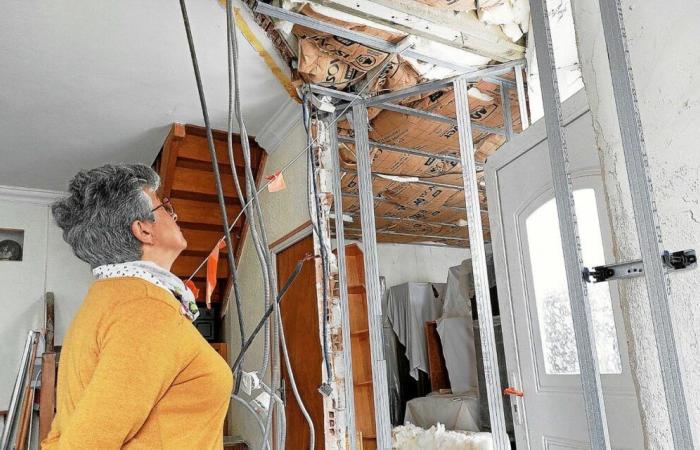
In the middle of the peaceful alley in the Brest district of Saint-Marc, Nicole's house has retained the charm of the 1930s. A solid construction spared by the bombings of the Second World War.
Covered floors and ripped ceilings: the house has been delivered to the companies for several weeks. Not for a simple renovation. The smell of fungicide betrays the presence of a wood-eating fungus feared by property owners. The rot is eating away at the neighborhood, house after house.
The situation is far from isolated, confirms Arnaud Coudray, boss of BZH Qualité in Saint-Évarzec (29) and Lannion (22), one of the many companies specializing in the treatment of dry rot: “There is a significant increase in number of construction sites, almost no Breton municipality escapes it. Particularly in Finistère where the company's activity has doubled in a few years. The only Breton department to have issued an order requiring a diagnosis added, in January 2024, Riec-sur-Bélon and Bannalec to the list of municipalities most at risk. This brings to 22 the number of municipalities registered on this blacklist, the only indicator of the evolution of the situation in Brittany.
“The box remained in my hands”
At Nicole's house, the infestation was discovered by chance. “It was at Christmas,” rewinds the septuagenarian. My daughter came for the holidays, we decided to tidy up her old room upstairs. » Under the attic, she begins to take a first box out of the cupboard: “It stayed in my hands”. The dry rot was there, “a whitish spot the size of a doormat”. A fear confirmed, a few weeks later, in light of the first expertise. The fungus had developed due to a water leak in the roof. The hammer blow for the distraught retiree: “I wondered if we should demolish the house”.
Rising water by capillary action, gutter leaks… The origins of the infestations are multiple, but share one thing in common, according to the entrepreneur: “Houses have become more and more airtight without always having been insulated in the best possible way” .
In the frame and walls
In Brest, the treatment of the framework forty years earlier did not save the family home. Under the paneling and insulation, the rot spread, eating away at the framework before settling in the stone walls, in the absence of ventilation between the roof and the insulation.
So, at the end of the summer, the companies began by dismantling part of the roof to allow the framework to be treated and reinforced. “We had to replace pieces of battens, joists and beams,” describes Nicole. A treatment was injected into the walls to stop the spread of the fungus and suppress it.
In her bad luck, however, the retiree discovered the presence of the fungus early enough. “A smell of undergrowth or baseboards that are starting to buckle can alert you. But once the fungus is there, it can progress by 12 cm per day,” describes Arnaud Coudray. If nothing is done, in a few months, the bill can quickly soar, going from a few thousand to several tens of thousands of euros.
Patience and solidarity
As in most cases, the loss was not covered by insurance, and Nicole has been living in her house without insulation since the beginning of autumn. She is waiting for work to continue by visibly overwhelmed craftsmen. The septuagenarian has no choice but to be patient: “I’m waiting for them. In any case, the winter is going to be hard because the insulation of the roof will not be redone immediately. I have to continue dismantling the partitions.” A long work carried out thanks to the solidarity of those close to him.
For the moment, she lives in the 40 m² of the rear part of her house, spared from rot, with the hope of providential support from her supplementary pension fund which is studying the possibility of exceptional assistance. “A new bottle in the sea,” says Corinne, a friend mobilized by her side. If it were to be accepted, it would only cover a tiny part of the cost of the project in any case. Without the help of her children, the septuagenarian would have been unable to pay for the 45,000 euros of work intended to erase the damage caused by dry rot. Beyond treating the fungus, it is the cost of reconstruction work that weighs the most.
The only satisfaction is that once the source of humidity has been eliminated, “the dry rot will not return if the work has been done according to the rules of the art,” reassures the contractor.





